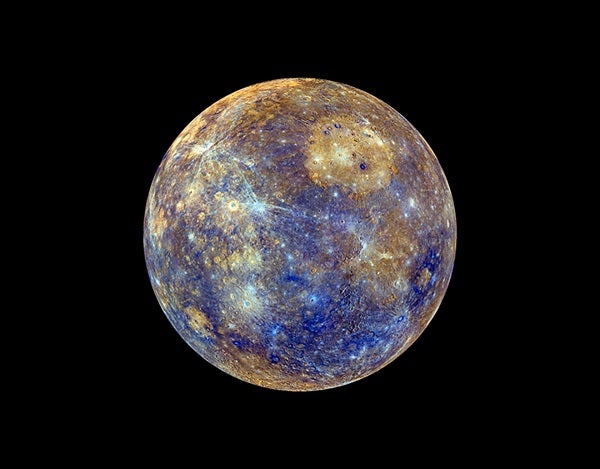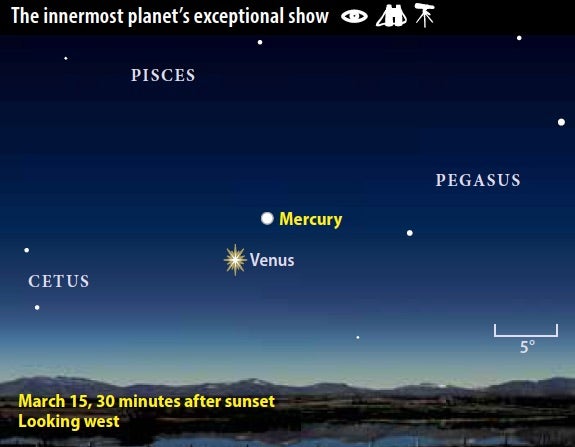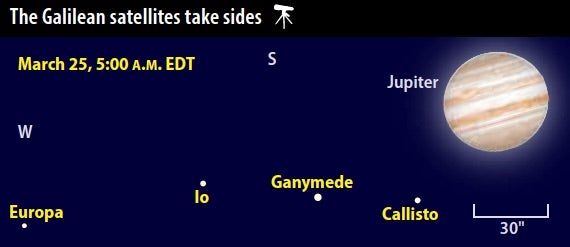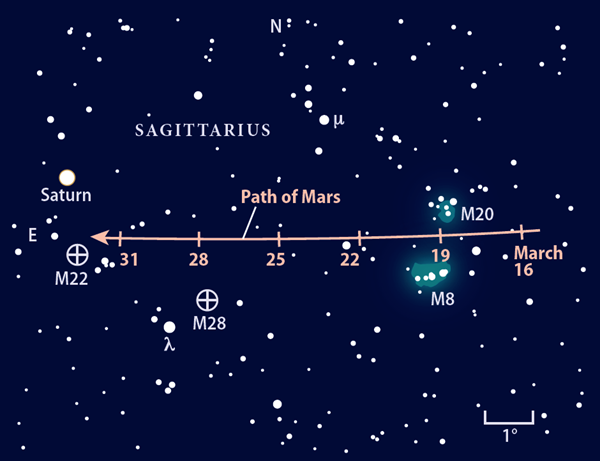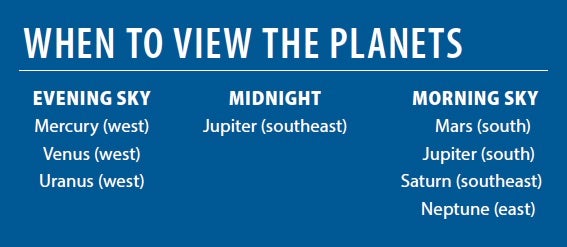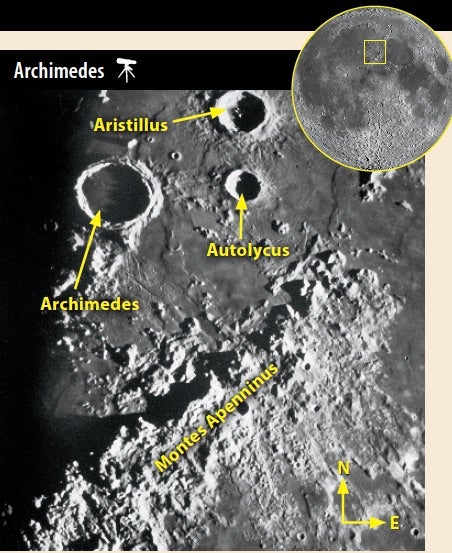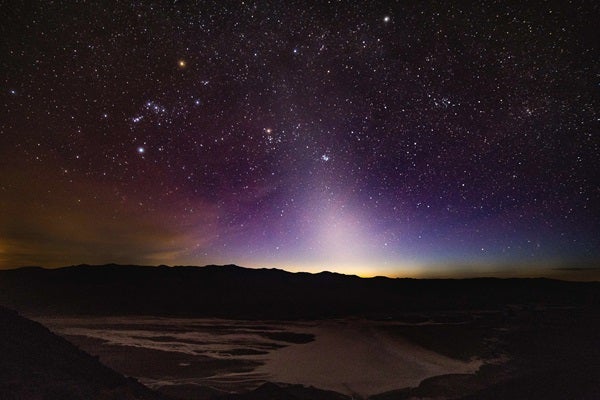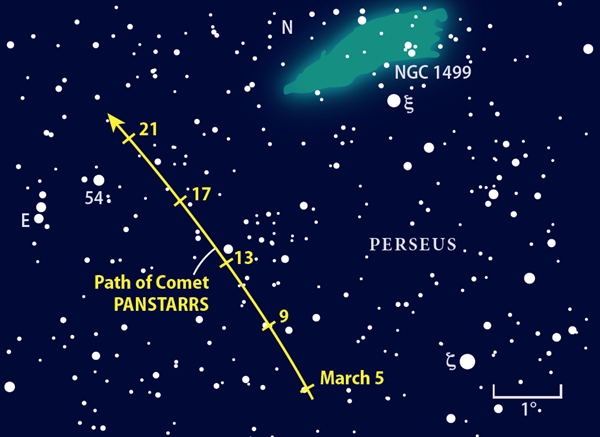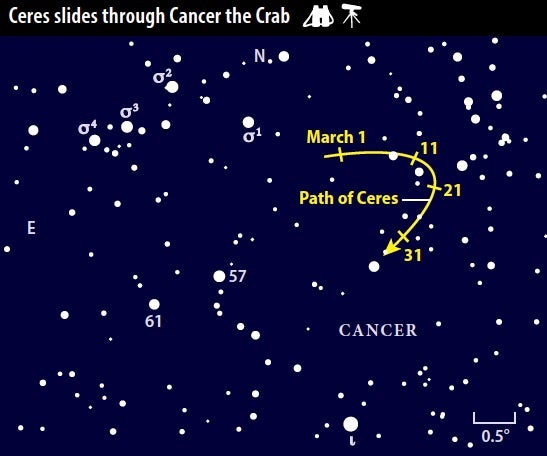Mercury and Venus rule the early evening sky, a pair of bright worlds seemingly tethered to each other for much of March. Uranus joins the party late in the month as it wraps up a fine evening appearance, though you’ll need binoculars to see its fainter glow. Not to be outdone, the morning sky features three bright planets — Mars, Jupiter, and Saturn — that grow more prominent by the week.
As March begins, Mercury appears deepest in evening twilight. In the Northern Hemisphere, the innermost planet has a deserved reputation for being an elusive target. Its tight orbit around the Sun means it never strays far from our star, so it typically appears in twilight either shortly after sunset or before sunrise.
But two factors make its appearance this month stand out. First, the ecliptic — the apparent path of the Sun across the sky that the planets follow closely — makes a steep angle to the western horizon after sunset. Mercury’s elongation from the Sun thus translates mostly into altitude.
But the bigger reason for Mercury’s easy visibility in March is its proximity to Venus. Earth’s closest planetary neighbor shines brilliantly at magnitude –3.9 and stands out in the western sky after sundown. Locate it, and finding nearby Mercury will be a snap. The two remain in a single binocular field during March’s first three weeks.
You can start searching for the planets early this month. On the 1st, Venus hangs 5° above the horizon a half-hour after sunset and Mercury appears 1.8° to its lower right. Mercury glows at magnitude –1.3, about 10 times dimmer than its companion, but shows up nicely through binoculars and should be visible to the naked eye in good conditions.
Mercury passes 1.4° due north (to the upper right) of Venus on March 5. Five days later, Venus stands 7° above the western horizon 30 minutes after sunset and Mercury appears 3° higher. A telescope reveals essentially no changes to Venus’ size and shape, but Mercury now shows a disk that measures 6.5″ across and is 64 percent illuminated.
The innermost planet reaches its peak at greatest elongation March 15. It then lies 18° east of the Sun and stands 12° high in the west 30 minutes after sundown. (It’s still 6° high in a darker sky a half-hour later.) Although it has dimmed to magnitude –0.4, that’s brighter than any other early evening object except for Venus and the night sky’s brightest star, Sirius. A telescope shows Mercury’s 7.3″-diameter disk, which appears slightly less than half-lit.
After greatest elongation, the innermost planet sinks lower with each passing day. It passes due north of Venus again March 17, this time at a distance of 4°. Be ready to capture some twilight shots on the 18th, when a crescent Moon stands 4° to Venus’ left and Mercury appears the same distance to Venus’ upper right. The trio stands 10° high 30 minutes after sunset.
Mercury fades quickly as it falls toward the Sun. The planet becomes a challenge in twilight by the 23rd, when it glows at 2nd magnitude. Mercury will pass between the Sun and Earth on April 1, setting up a poor morning appearance in late April.
Meanwhile, Venus continues to climb away from the Sun. Its ascent sets up a close conjunction with Uranus on March 28. From North America that evening, the two lie a mere 4′ apart, their closest since the same date in 2003. Uranus glows at 6th magnitude, however, and will be hard to see in twilight. Track Venus through binoculars or a telescope as twilight darkens and watch for the more distant planet to pop into view.
You’ll have an easier time catching Uranus in early March when it stands 25° high in the west once twilight fades to darkness. Look for it 2.3° due west of 4th-magnitude Omicron (ο) Piscium in the southeastern corner of Pisces the Fish.
If you target the planet through a telescope, wait until an hour or two before dawn. This is when it appears highest in the south and its light passes through less of Earth’s image-distorting atmosphere. You’ll be rewarded with sharper views of fine details in the jovian cloud tops.
Jupiter’s equatorial diameter grows from 39″ to 43″ during March, plenty big enough that any scope can deliver exquisite views. The most prominent features are the two dark belts that straddle a brighter zone coinciding with the equator. More subtle aspects abound on the periphery of both belts.
Also keep an eye out for the Great Red Spot. This massive storm lies near the southern edge of the South Equatorial Belt and displays a distinctive pinkish-red color. You can see it about half the time — whenever Jupiter’s rotation places it on the hemisphere facing Earth. The planet spins once on its axis in less than 10 hours, so if you don’t see it right away, you shouldn’t have to wait long.
Once you’ve examined Jupiter’s disk, look for the planet’s four bright moons. They present a constantly changing vista as they revolve around the planet. Io shifts position most quickly because it circles the planet in only 1.8 days, while Europa takes 3.6 days, Ganymede 7.2 days, and Callisto 16.7 days. These movements occasionally bring all four satellites to one side of the planet. For North American observers, this happens four times in March — on the 1st, 11th, 24th, and 25th — but the events on the 11th and 25th provide the best views.
The moons all orbit Jupiter in the same plane, and that plane tilts significantly to our line of sight this month. This means outermost Callisto can pass north or south of the planet. You can see one of these rare events the night of March 24/25, before Callisto joins the other three moons west of Jupiter.
A few hours after Jupiter rises, Mars pokes above the southeastern horizon. The Red Planet has begun what will be its finest appearance in 15 years. Although it won’t peak until July, the rocky world improves noticeably in March. Observers and astroimagers who want to get the most out of this summer’s show should start honing their skills now.
Mars begins the month among the background stars of Ophiuchus, some 12° east-northeast of Antares in neighboring Scorpius. The planet glows at magnitude 0.8, a touch brighter than the star. If you take a moment to study the colors of the two objects, you’ll understand why ancient observers named the star Antares, which literally means “rival of Mars.”
The planet moves steadily eastward against the starry backdrop during March. It crosses into Sagittarius on the 12th, setting up a series of wonderful conjunctions with some of the Milky Way’s best and brightest deep-sky objects. It passes midway between the Lagoon Nebula (M8) and the Trifid Nebula (M20) on the morning of March 19, providing a stunning binocular view and a prime photo opportunity. The trio climbs 20° above the horizon by 5:30 a.m. local daylight time, just before twilight starts to dim the Milky Way star clouds.
As Mars continues across Sagittarius, it meets up with the 7th-magnitude globular star cluster M28 on March 28. The planet appears 1.3° north of the cluster that morning. Mars ends the month just 0.9° west-northwest of an even brighter globular, 5th-magnitude M22. The planet then shines at magnitude 0.3, some 60 percent brighter than it started March.
Mars brightens this month in part because its apparent diameter grows by 25 percent, from 6.7″ to 8.4″. You should be able to tease out a few surface details during moments of steady seeing, particularly as it grows larger late in the month. Look for the distinctive dark smudge of Syrtis Major — one of the planet’s most conspicuous features — on March’s final few mornings.
If you track Mars all month, you’ll notice it approaching another prominent point of light. On the 31st, the Red Planet pulls within 1.7° of Saturn. The ringed planet orbits much farther from the Sun than Mars and thus moves eastward more slowly. It remains about 2° north of M22 all month. Saturn appears conspicuous at magnitude 0.5, and its golden hue offers a striking color contrast with its ruddy neighbor.
Enjoy viewing Saturn against the Milky Way backdrop with your naked eye or binoculars. You’ll need a telescope to see its superb rings, which span 37″ and tilt 26° to our line of sight this month.
You also might catch a brief glimpse of Neptune at the end of March. The outer planet rises an hour before the Sun on the 31st and likely will be lost in twilight from mid-northern latitudes. (Your chances increase the farther south you live.) It will return to view for everyone by late April.
Towering turrets, chains of pointy peaks, and a parade of rugged crater walls highlight any First Quarter Moon. For the best views, look along the terminator — the dividing line between day and night that cuts the Moon in half. The evening of March 24 provides splendid views as the rising Sun casts long shadows.
North of the lunar equator, Montes Apenninus (Apennine Mountains) lies west of Mare Serenitatis (Sea of Serenity). This mountain arc forms the southeastern edge of the giant Mare Imbrium. The massive impact that created this basin threw out an incredible amount of material. Later on, lava welled up from below and buried much of it. But some of this excavated material remains on view, most prominently on the southeastern side of the Apennine chain.
Inside the mountainous arc lies the attractive circular form of Archimedes. Acting like a canvas, the crater’s smooth floor displays a remarkable series of saw-toothed shadows cast by the rim. Lunar cartographers named this 52-mile-wide crater after the famed Greek mathematician and physicist of the third century b.c. After looking at this striking feature, take a moment to enjoy the smaller craters Aristillus and Autolycus nearby.
You can heighten your experience by watching carefully during the evening hours. The long daggers of darkness knifing westward onto Archimedes’ floor retreat with each passing hour. By March 25, the much shorter shadows are merely pointy, and they disappear in a couple more nights.
March is a lean month for meteor observers. No major showers occur, and the only minor one (the Gamma Normids) resides deep in the southern sky. Still, dark skies always offer a chance to see sporadic meteors.
The dust particles that give rise to meteors are debris from asteroid collisions and comets passing through the inner solar system. This dust concentrates along the ecliptic, the plane in which the planets orbit. When the ecliptic angles steeply to the western horizon after sunset, as it does every March, the dust appears as a pyramidal glow to the naked eye. To see this so-called zodiacal light, plan to observe sometime between March 3 and 18, when the Moon is out of the evening sky. Then, find a site far from the city, wait for twilight to fade away, and search for the soft glow.
Going to California
It appears as though our extended drought without a bright comet will continue through the spring. But while Comet PANSTARRS (C/2016 R2) may lack in luster, it shines for its consistency. This first-time visitor from the distant Oort Cloud should remain at 10th or 11th magnitude for several months.
Comet PANSTARRS lies high in the west after darkness falls in March. You can find it between the star patterns representing Perseus the Hero and Auriga the Charioteer. Deep-sky observers know this region best as home to the California Nebula (NGC 1499). The comet slides less than 5° southeast of the nebula in mid-March.
To best see PANSTARRS, you’ll want to observe it from a dark-sky site during the Moon-free window from March 5 to 21. If you happen to be out for a Messier marathon the weekend of March 16 and 17, spare a few minutes to track down C/2016 R2. A 4-inch or larger telescope will reveal the comet, but you’ll want to pump up the power to 150x or so to see subtle detail. Look for a fuzzy, out-of-round object with a brighter core and a more defined edge toward the southwest.
The enduring popularity of comets comes in part from their wide range of shapes and sizes. When located far from the Sun, they often mimic elliptical galaxies. And PANSTARRS qualifies — at its closest to the Sun this May, it will lie well beyond the orbit of Mars. But our comet currently lies in the Milky Way, far from any comparison galaxies. C/2016 R2 does share some characteristics with the nearby California Nebula, however: Both consist of gas and dust lit up by starlight. And there’s no doubt that somewhere within NGC 1499 lurks a star with an Oort Cloud of its own.
Discover the nearest dwarf planet
March offers a great opportunity to track down the king of the asteroid belt. Ceres dims from magnitude 7.4 to 8.0 this month, which puts it within range through binoculars or a small telescope from the suburbs. The object resides in Cancer, which stands high in the east at nightfall and passes nearly overhead around 10 p.m. local daylight time in mid-March.
Ceres lies about two binocular fields north of the Beehive star cluster (M44). You can get a head start by sketching a framework consisting of 4th-magnitude Iota (ι) Cancri and the group of four 5th- and 6th-magnitude stars labeled Sigma1 (σ1) to Sigma4 (σ4) Cancri on the chart below. Then head outside, dark adapt, and add the stars you see to the west of this field. One of these points of light will be Ceres. To find out which one, return to this field in a week or so and see which dot has shifted position.
Astronomers once thought Ceres was the supposed missing planet between Mars and Jupiter. It was later downgraded to an asteroid and then, in 2006, elevated to dwarf planet status. Italian astronomer Giuseppe Piazzi discovered Ceres on New Year’s Day 1801.

